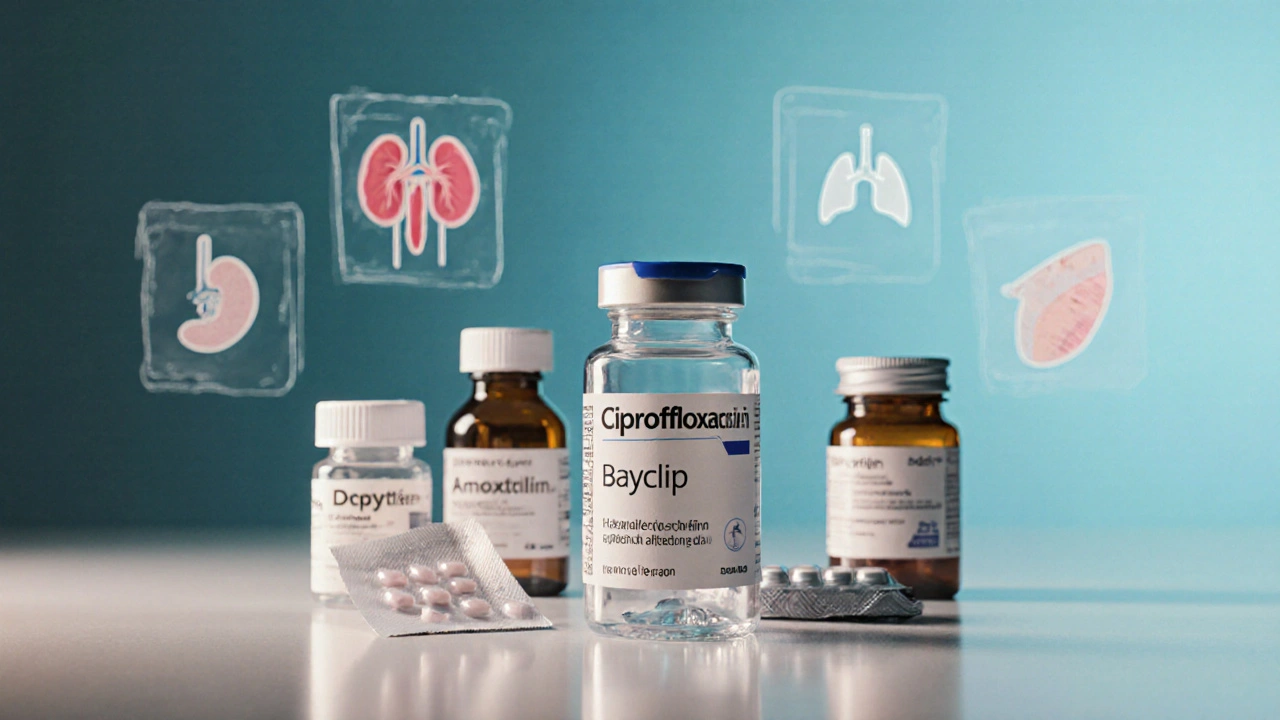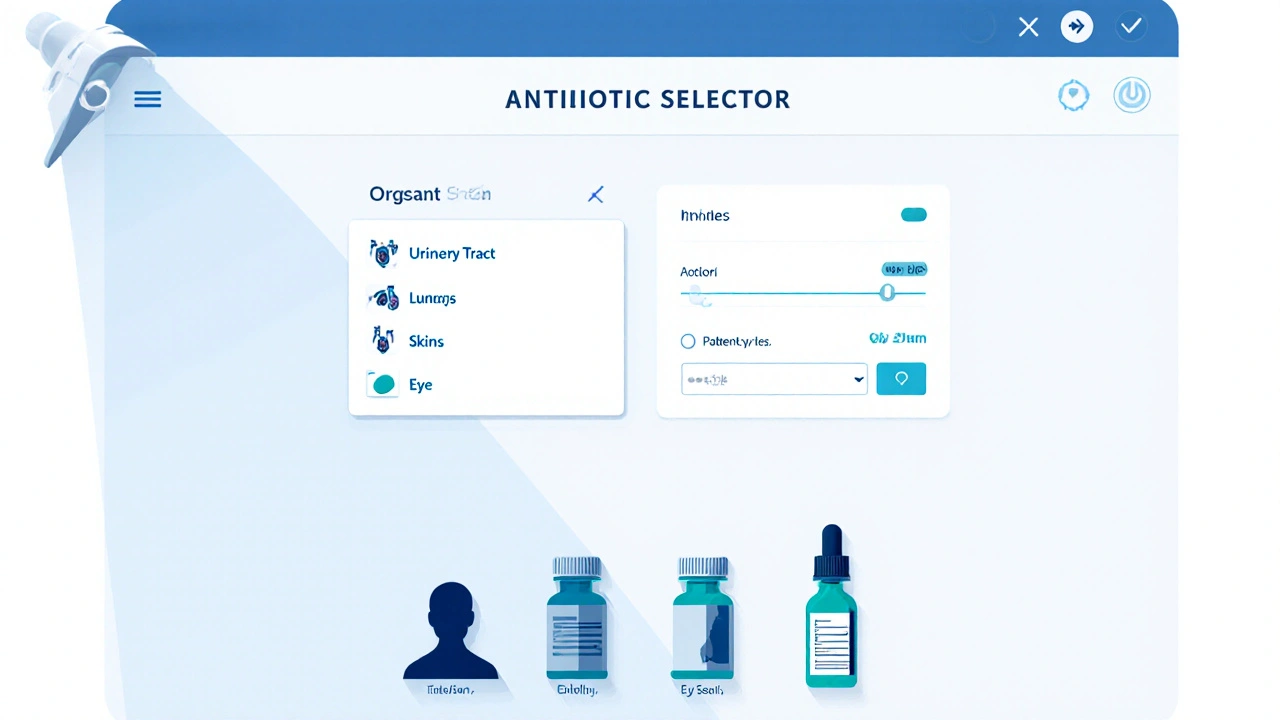Baycip vs Alternatives: Antibiotic Selector
Recommended Antibiotics
Antibiotic Comparison Table
| Antibiotic | Primary Use | Strengths | Side Effects |
|---|---|---|---|
| Baycip (Ciprofloxacin) | UTI, Respiratory, Skin Infections | Broad spectrum, effective against Pseudomonas | Tendon rupture risk, GI upset |
| Levofloxacin | Community-Acquired Pneumonia | Similar coverage, lower tendon risk | Tendon rupture, QT prolongation |
| Amoxicillin | Ear, Throat, Mild Respiratory Infections | Cheap, effective against strep | Allergic reactions |
| Doxycycline | Atypical Pathogens, Skin Infections | Good for MRSA, oral absorption | Photosensitivity, esophageal irritation |
| Azithromycin | Short-course Regimen | Convenient, good adherence | QT prolongation, liver changes |
When you need an antibiotic, choosing the right one can feel overwhelming. Baycip is the brand name for ciprofloxacin, a fluoroquinolone used for a range of bacterial infections. It’s popular because it’s available in tablet and eye‑drop forms, but it’s not the only option on the market. Below we break down how Baycip stacks up against the most common alternatives - from levofloxacin to amoxicillin - so you can pick the drug that fits your infection, health profile, and lifestyle.
Key Takeaways
- Baycip (ciprofloxacin) is a broad‑spectrum fluoroquinolone, excellent for urinary‑tract and respiratory infections.
- Levofloxacin offers similar coverage with a slightly better safety profile for tendon issues.
- Amoxicillin works well for ear, throat, and some respiratory infections but lacks activity against Pseudomonas.
- Doxycycline is a good choice for atypical pathogens and skin infections, though it can cause photosensitivity.
- Azithromycin provides a convenient short‑course regimen, ideal for patients who struggle with adherence.
How Baycip Works
Ciprofloxacin belongs to the fluoroquinolone class. It inhibits bacterial DNA gyrase and topoisomeraseIV, enzymes needed for DNA replication. By disrupting these processes, the drug stops bacteria from multiplying, leading to infection clearance. Its oral bioavailability exceeds 70%, meaning the tablet form reaches effective blood levels quickly.
When to Use Baycip
Doctors typically prescribe Baycip for:
- Complicated urinary‑tract infections (including those caused by Escherichia coli).
- Lower respiratory tract infections when Haemophilus influenzae or Streptococcus pneumoniae are suspected.
- Skin and soft‑tissue infections involving Pseudomonas aeruginosa.
- Eye infections (e.g., bacterial conjunctivitis) using the eye‑drop formulation.
Because fluoroquinolones carry a boxed warning for tendon rupture, they’re generally avoided in patients with a history of tendon disorders, the elderly, or those on corticosteroids.

Major Alternatives to Baycip
Below are the most frequently considered substitutes, each with its own strengths and drawbacks.
Levofloxacin
Levofloxacin is another fluoroquinolone, often chosen for community‑acquired pneumonia. It offers similar bacterial coverage but has a slightly lower risk of tendon injury. Doses are once‑daily, which can improve adherence.
Amoxicillin
Amoxicillin is a penicillin‑type beta‑lactam. It’s especially effective against ear infections, strep throat, and many mild respiratory bugs. However, it’s ineffective against organisms that produce beta‑lactamase unless combined with clavulanic acid.
Doxycycline
Doxycycline, a tetracycline, shines in treating atypical pathogens like Mycoplasma pneumoniae and certain skin infections (e.g., acne). It’s well‑absorbed orally and can be taken with food, but it can make skin sun‑sensitive.
Azithromycin
Azithromycin belongs to the macrolide class. Its long half‑life allows a three‑day regimen for many respiratory infections, making it a favorite for patients who struggle with longer courses. Resistance is rising, especially in Streptococcus pneumoniae.
Cephalexin
Cephalexin is a first‑generation cephalosporin. It’s a go‑to for uncomplicated skin infections and certain urinary‑tract infections. While generally safe, it’s not as potent against Pseudomonas as ciprofloxacin.
Moxifloxacin
Moxifloxacin is a newer fluoroquinolone with enhanced activity against Gram‑positive bacteria, making it useful for chronic obstructive pulmonary disease (COPD) exacerbations. It shares the class‑wide safety concerns, so it’s reserved for cases where other agents fail.
Side‑Effect Profile Snapshot
| Antibiotic | Typical Side‑Effects | Major Safety Warning |
|---|---|---|
| Baycip (Ciprofloxacin) | Nausea, diarrhea, headache | Risk of tendon rupture & cartilage damage |
| Levofloxacin | GI upset, dizziness | Similar tendon risk, QT prolongation |
| Amoxicillin | Rash, mild diarrhea | Allergic reactions in penicillin‑sensitive patients |
| Doxycycline | Esophageal irritation, photosensitivity | Potential for intracranial hypertension |
| Azithromycin | Abdominal pain, mild liver enzyme changes | Cardiac arrhythmia (QT prolongation) in high doses |
| Cephalexin | Diarrhea, nausea | Rare severe allergic reactions |
| Moxifloxacin | Vomiting, dizziness | Same fluoroquinolone warnings + liver toxicity |
Decision‑Making Checklist
- Infection type: Is the bug likely a gram‑negative rod (e.g., E. coli) or a gram‑positive cocci?
- Patient age & comorbidities: Elderly or those on steroids have higher tendon‑risk with fluoroquinolones.
- Allergy history: Penicillin allergy steers you away from amoxicillin.
- Adherence concerns: Short‑course (azithromycin) or once‑daily (levofloxacin) may be preferable.
- Resistance patterns: Local antibiogram data can indicate rising macrolide resistance, making fluoroquinolones more attractive.
Choosing the Right Antibiotic for You
If you’ve been diagnosed with a urinary‑tract infection and your doctor suspects a resistant gram‑negative organism, Baycip’s strong activity against E. coli and Pseudomonas makes it a solid first pick-provided you have no tendon‑risk factors. For community‑acquired pneumonia in a healthy adult, levofloxacin or azithromycin may be easier to take and carry fewer tendon warnings.
When the infection is clearly streptococcal (like strep throat), amoxicillin remains the cheapest, safest, and most effective option. For skin infections where Staphylococcus aureus is involved but you’re concerned about MRSA, doxycycline or clindamycin might be better choices.
Always discuss your full medical history with a pharmacist or prescriber. They can weigh the pros and cons, look at local resistance data, and ensure the antibiotic you receive matches the infection’s likely cause.

Frequently Asked Questions
Can I take Baycip and a dairy product together?
Ciprofloxacin’s absorption drops by up to 20% when taken with calcium‑rich foods. It’s best to take the tablet at least two hours before or after dairy, antacids, or calcium supplements.
How long does it usually take for Baycip to clear an infection?
Most patients feel better within 48‑72hours, but you should finish the full prescribed course (typically 5‑7days) to prevent resistance.
Is Baycip safe during pregnancy?
Fluoroquinolones are categorized as Pregnancy Category C in the UK, meaning they should be used only if the benefits outweigh potential risks. Usually, safer alternatives like amoxicillin are preferred.
What should I do if I develop tendon pain while on Baycip?
Stop the medication immediately and contact your healthcare provider. Early detection can prevent a full‑blown tendon rupture.
Are there generic versions of Baycip?
Yes, ciprofloxacin is available as a generic tablet and eye‑drop in the UK. Prices vary between pharmacies, but the active ingredient is identical.
Choosing the right antibiotic isn’t just about price-it’s about matching the drug’s spectrum, safety, and dosing schedule to your specific infection and personal health profile. Use this comparison as a roadmap, but let your clinician make the final call.





12 Comments
Josh Grabenstein
October 3, 2025The pharma giants want you thinking Baycip is the only answer, but they're hiding cheaper generics behind the curtain :)
Marilyn Decalo
October 10, 2025Honestly, the whole “choose the broad‑spectrum one” narrative feels like a plot twist nobody asked for. Baycip shines in UTIs, sure, but the tendon warnings read like a horror script. If you’re over 60 or on steroids, you might want to audition Levofloxacin for a safer cameo. At the end of the day, the cheapest drama is the one that isn’t your gut bleeding out.
Mary Louise Leonardo
October 17, 2025Look, antibiotics are like the cast of a reality show – each thinks they're the star. Ciprofloxacin (Baycip) walks in like the tough guy, taking down gram‑negative villains with swagger. But the same swagger can lead to tendon drama that you don’t want in your plot. Levofloxacin is the same guy with a better safety script, while amoxicillin plays the friendly neighbor who only handles mild bugs. Doxycycline brings the sun‑sensitive vampire to the party, and azithromycin shows up with a short‑term vibe. If you’ve got a stubborn infection, pick the actor that matches the role, not the one with the flashiest trailer. Remember, the local resistance charts are the real critics that decide who gets the lead. So, choose wisely and keep the sequel from being a failure.
Alex Bennett
October 25, 2025From a philosophical standpoint, the selection of an antibiotic mirrors the quest for the perfect metaphor – elusive yet necessary. Baycip offers a broad spectrum, which is admirable, though its tendon risk is a reminder that power comes with consequences. Levofloxacin, with a slightly milder safety profile, could be seen as the more measured existential choice. Amoxicillin, while narrow, fulfills its purpose with elegant simplicity, much like Occam’s razor. Ultimately, the clinician’s judgment is the Socratic dialogue that balances efficacy with patient well‑being.
Mica Massenburg
November 1, 2025You think it’s drama, but the FDA paperwork tells a quieter story. Still, don’t trust the labels – they’re written by the same people pulling the strings.
Sarah Brown
November 8, 2025Choosing the right antibiotic is more than a checkbox exercise; it’s a collaborative decision between you, your clinician, and the microbiology lab.
First, identify the infection site – a urinary tract infection demands a drug that penetrates the bladder effectively.
Ciprofloxacin (Baycip) shines here because it reaches high concentrations in urine and tackles resistant E. coli strains.
However, we must weigh the tendon rupture risk, especially in patients over 60, those on corticosteroids, or anyone with a history of tendon problems.
For those high‑risk groups, levofloxacin often provides comparable coverage with a slightly lower tendon profile.
If the bug is a simple gram‑positive organism, amoxicillin remains the gold standard due to its safety, low cost, and narrow spectrum.
When skin infections involve MRSA or atypical pathogens, doxycycline steps in with good oral absorption and anti‑inflammatory benefits.
Azithromycin offers a short three‑day regimen, which can improve adherence for patients who struggle with longer courses.
Never forget the local antibiogram – it tells you which antibiotics the local bacterial population still respects.
If resistance rates for macrolides are soaring in your area, leaning on a fluoroquinolone may be justified despite its warnings.
Always discuss any history of heart rhythm issues, because both levofloxacin and azithromycin can prolong the QT interval.
Pregnant patients should generally avoid fluoroquinolones; amoxicillin or cephalexin are safer alternatives.
For ocular infections, the Baycip eye‑drop formulation bypasses systemic exposure, reducing systemic side‑effects.
Remember to take ciprofloxacin on an empty stomach, away from calcium‑rich foods, to maximize absorption.
If you experience sudden tendon pain, drop the medication immediately and seek medical attention – early action can prevent a rupture.
By keeping an open dialogue with your healthcare team and staying informed, you empower yourself to make the safest, most effective choice.
Max Canning
November 16, 2025Yo, love the checklist! I always grab the short‑course azithro when I’m on the go – it’s a game‑changer for busy folks.
Nick Rogers
November 23, 2025Indeed, the pharmacokinetic profile of ciprofloxacin warrants careful dosing; adherence to guidelines is paramount.
Tesia Hardy
December 1, 2025Totally agree, but remeber that takin it with dairy can cut the effect in half – so dont forget the timing!
Matt Quirie
December 8, 2025While fluoroquinolones provide robust gram‑negative coverage, their safety warnings must be balanced against patient comorbidities, especially in the geriatric population.
Pat Davis
December 15, 2025Consequently, clinicians should prioritize agents with the narrowest effective spectrum, reserving ciprofloxacin for cases where alternative options are contraindicated or have demonstrated resistance.
Mary Wrobel
December 23, 2025In the end, picking the right antibiotic is like choosing the right brush for a painting – it shapes the final masterpiece.